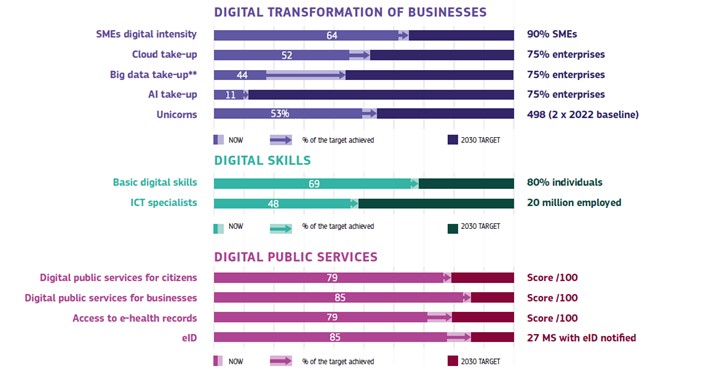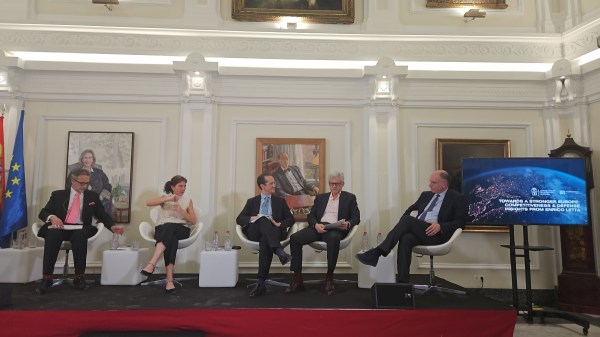Last year, we welcomed the launch of the EU’s Digital Decade by outlining how connectivity defines the magnetic North of the Digital Compass. In September 2023, the Commission issued a first report providing a snapshot of the situation at a time when Member States had not yet outlined their roadmaps for realising targets in this (and other) domain(s). Now, almost one year later, the Commission has issued in July a second report, the report on the state of the Digital Decade 2024. Here, a more differentiated picture emerges.
As reported, the EU has lagged behind in all three key dimensions for competitiveness of innovation, production, and adoption, especially in critical technological developments affecting performance in digitalization and raising concerns. Furthermore, the EU’s lag in the ICT race has resulted in a decrease in the global revenue share of EU GDP in the ICT market by 10.5% over the decade between 2013 and 2022, substantially effecting productivity gains.
The European Recovery and Resilience Facility (RRF) has made an important contribution to advancing the Digital Decade policy programme, but the time remaining to achieve the targets is many times longer than the agreed 2030 timeframe, and the progress is uneven across countries and targets.
Digital Infrastructures: still far from 2030 targets

Tracking progress against the targets based on 2023 data, the report highlights the limited growth in connectivity coverage, especially in terms of quality. Only 64% of households have access to fibre and the rate of progress (13.5%) is far lower than what it is needed to reach the gigabit target by 2030. Moreover, there is an extremely low uptake of Gigabit connections of just 18.5%. Coverage of high quality 5G extends only to merely 50% of the EU territory (based on main pioneer band), with most of the deployment of 5G not being standalone. Early deployment of 5G SA architecture provide region first-mover advantages for new services. As the ETNO report on the state of digital communications 2024 showed , gigabit-capable coverage and 5G usage is progressing more slowly in Europe than in other regions.
Over and above the seven jurisdictions whose policies had been found satisfactory, a further eight no longer receive connectivity-related recommendations. On last year’s report, the European Commission called on Germany to step up its efforts in connectivity, which reach 74.7% VHCN coverage and 5G overall coverage of 98.1%. Spain performs exceptionally well in fibre connectivity. FTTP stands at 95.2% and 5G coverage at 92.3%, much above the EU average (78.8% and 89.3% respectively).
Overall, therefore, there seems to be only one strong conclusion: whatever their expected performance, all countries need to ensure a focused pursuit of the EU connectivity targets, particularly in terms of high-quality and for all connectivity. The investment required to meet the connectivity targets is still significant, at EUR 200 billion, and policies must allow operators to make a return on their investment, where funding for the connectivity ecosystem and hard-to-reach areas is key.
Lastly, the data shows that the deployment of an estimated 1186 edge nodes (out of the targeted 10,000) is largely inadequate and is mainly used for testing and research rather than being fully operational and available for general use. Increasing public investment through agile IPCEI initiatives, incentivising private investment, as well as public sector adoption of the cloud would lead to further deployment.
Digital transformation: the adoption gap

With limited annual progress, businesses’ uptake of digital technologies remains a key challenge. Cloud adoption has increased by only 7%, falling short of the 9% needed to meet the target. There has been no noticeable improvement in AI take-up, and merely 32% of European companies have adopted data analytics.
The digitalisation of SMEs is also progressing too slowly and unevenly across the EU, with an annual increase of only 2.5%, which is half of the growth rate required to achieve the target. The startup ecosystem, despite some progress – 5.6% growth in the number of unicorns – remains underdeveloped. The EU is home only to 263 unicorns (13% of the total), compared to 387 in China, and 1 539 in the USA, partly due to a lack of private capital.
One of the major challenges faced in the EU’s digital transformation, is the limited spread of digital technologies beyond large cities, linked to increasing digital divides and to the slow digitalisation of businesses, especially SMEs. Convergence is still lagging as major population centers often concentrate investments. A successful Digital Decade will therefore not be possible without greater focus on inclusiveness and the participation of all actors at all levels including regions and cities.
Efficient, user-friendly, accessible, and coherent digital public services are key to bringing citizens and SMEs online. Both scores for digital public services for citizens and for businesses remain below the 2023 score required to be on track towards the 2030 target (7.8 points below for citizens and 5.4 points below for businesses). In addition, local public administration services still need to be considered as they are a key factor for trust and efficiency and often lack harmonisation and digital resources.
Digital transformation: digital trust and skills gap
Very significant work remains to be done to reach the 2030 targets on digital skills: only 55.6% of EU’s population has at least basic digital skills and, at the current pace, the number of ICT specialists will reach just 12 million by 2030 – well below the EUR 20 million target and amid growing competition for digitally skilled talent.
Online risks have been identified as one of the most destabilising factors for societies, requiring comprehensive, coordinated action across borders and actors. In particular, the protection of minors online is one of the main concerns for a third of respondents to the Eurobarometer (+10 percentage points since last year).
The EU’s cybersecurity landscape continues to impact trust and digital uptake. Progress in digitalisation can only go hand in hand with adequate cyber resilience. While there is a consensus that cybersecurity is a high priority for businesses (71%), acting remains the main challenge. And to track progress on cybersecurity and cyber resilience, it is essential to create and monitor KPIs for this fundamental indicator (e.g. investment and specific expertise), which are surprisingly still missing from the current Digital Decade targets.
Policies and roadmaps to achieve 2030 digital targets
According to the report, Member States propose measures amounting to EUR 251.9 billion investments (including EUR 168 billion from the public budget which amounts to 1% of the EU’s GDP) focused mainly on semiconductors (24%), connectivity (17%) and basic digital skills (15%). In terms of policies, it recommends:
- First to swiftly implement and enforce the regulatory frameworks, engaging in more coordination and cohesion across the board, in particular, the reduction of the administrative burden, ultimately streamlining processes for businesses and citizens.
- Second, Member States should intensify their efforts to strengthen their competitiveness, encompassing productivity, resilience, greening and sovereignty. This requires increased investments, with significant mobilisation of further public and private investments, as well as a step change in addressing obstacles to the single market.
- Thirdly, foster the dissemination of digital technologies across society and regions, particularly by developing cooperation and collaboration.
- Fourthly, building on citizens’ growing perception of the potential of the digital transformation to foster a smart green transition, better understanding the synergies between the twin transitions and possible leverages will be key.
- Fifth, a common effort is required to ensure that people and their rights, are at the centre of the digital transformation, ensuring that they have the adequate digital skills. And actions to address inequalities, online discrimination, divides and social exclusion in daily lives are critical to prevent a growing digital disconnect from evolving into digital discontent.
- Finally, the sharing of best practices has been prioritised by the Commission and Member States as a key driver of a successful digital transformation.
For a comprehensive set of recommendations, refer to our vision EU 2024-2029: Forging a competitive path, which sets out the main challenges facing the region and makes recommendations to promote a strong EU Competitiveness Deal.
Finally, the Commission will also start preparing the review of the Digital Decade policy programme, foreseen for June 2026.











